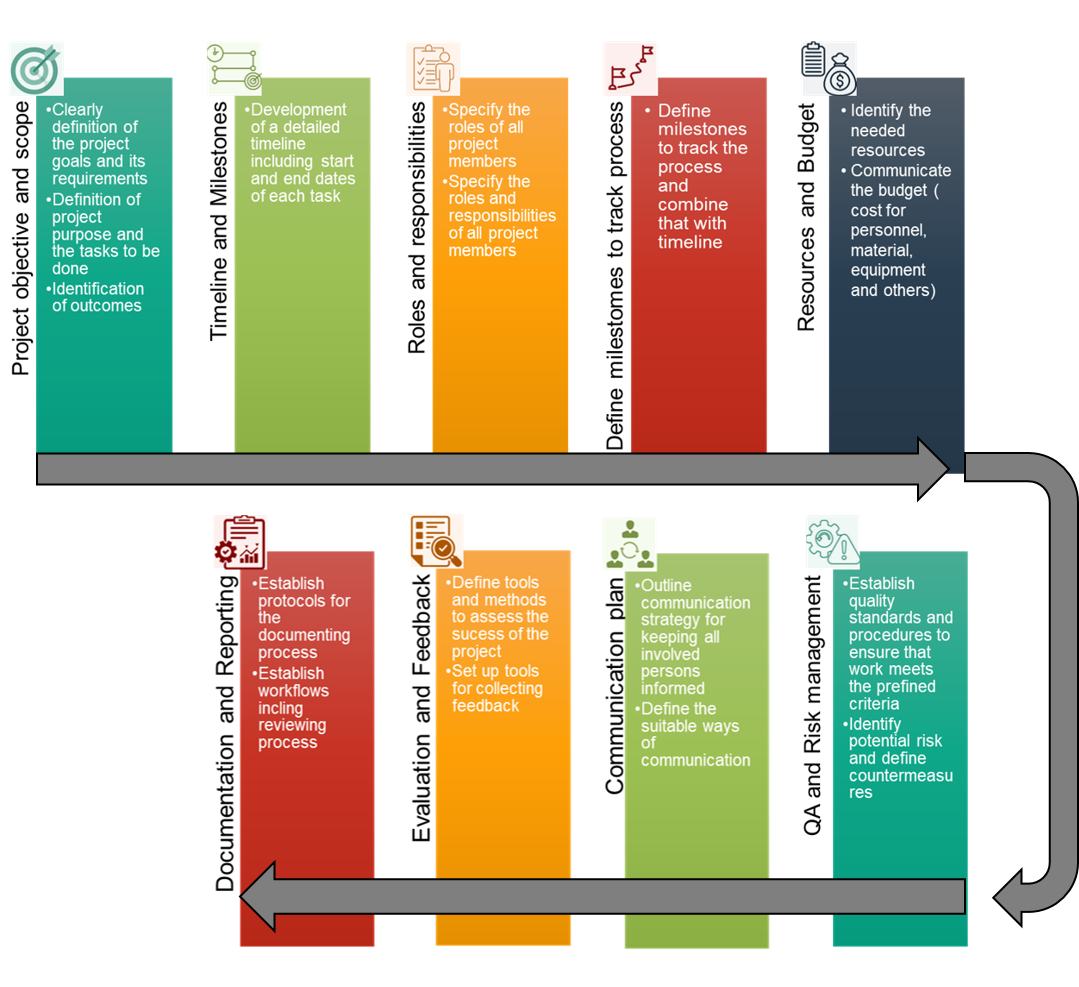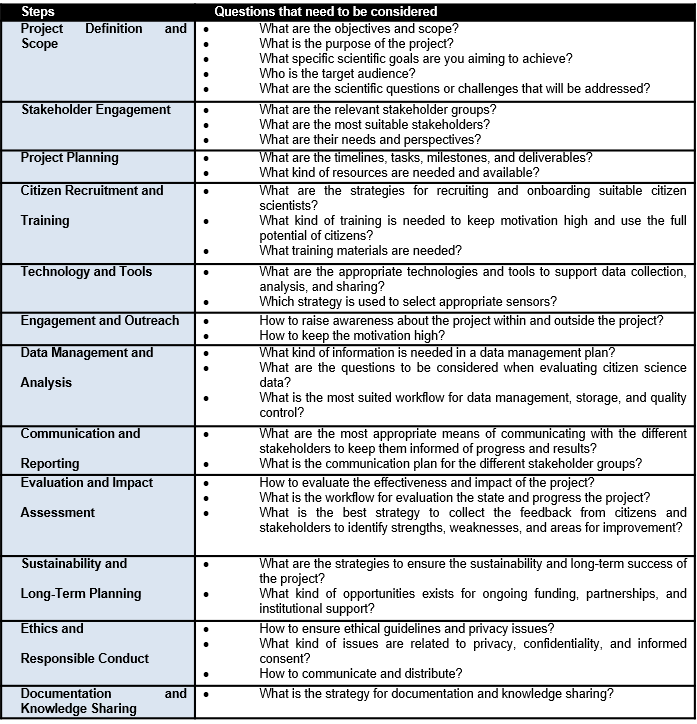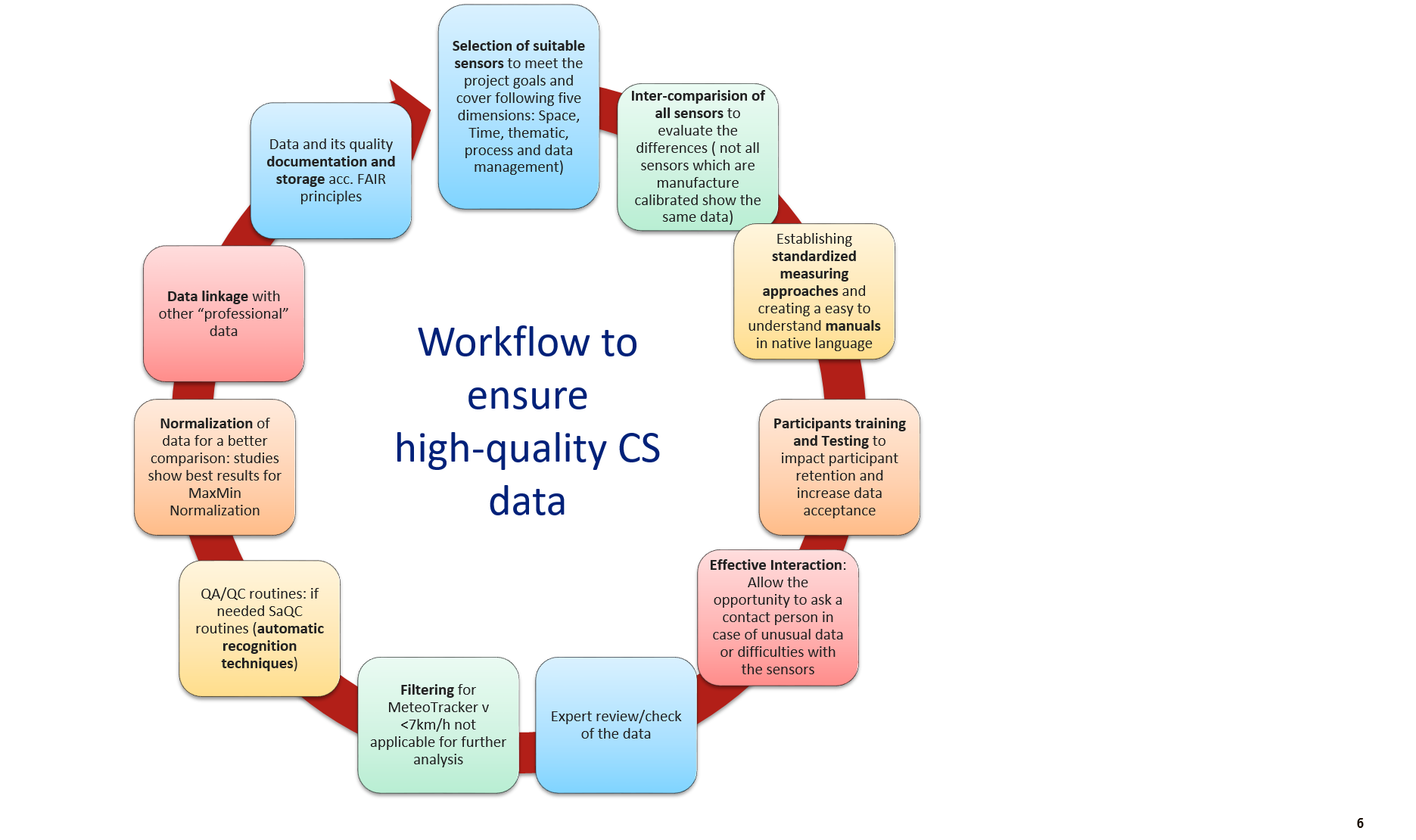Step 2: Setup of implementation plan
Develop a plan that outlines the steps necessary to achieve project outcomes. An implementation plan outlines the steps and processes required to achieve a specific goal or project. It will usually include a number of different components to ensure a smooth and successful implementation. The plan should include the following items :

By following these steps, you can create a comprehensive implementation plan that sets clear goals, allocates resources effectively, mitigates risk and ensures successful execution.
Depending on the specific needs and preferences of the project team, there are many tools available (e.g. Microsoft Project, Gantt charts, Trello project management tools) that offer different features and functionalities for creating schedules, allocating resources, tracking progress and managing dependencies. It is important to choose the one that best fits the requirements and workflow of the project.

Many of the systematic biases in citizen science data are the same biases that occur in professionally collected data. This CS data may contain errors and biases, but existing statistical and modelling tools can mitigate these errors and biases. Tools for automated Quality Control for outlier detection and drift detection can be easily implemented. The only known bias specific to citizen science is the potentially high variability among volunteers in terms of demographics, skills, effort and commitment.
Workflow to ensure high-quality CS data

Following questions to be answered to ensure high-quality CS data:
| Steps | Questions to be answered |
|---|---|
| Selection of suitable sensors | See other point |
| Intercomparision of different sensors | See other point |
| Standardized measuring approaches |
• Are the standards to be followed for the used measuring technique? • Do you establish project-specific standards? • Does the standard define the whole data cycle? |
| Participant training and testing |
• Are you planning to do training workshops for the citizens? • Are you provide online training and consultation? • Did you provide support in testing the sensors? |
| Effective Interaction |
• What kind of tools are established for interaction with the citizens? • Do you plan regular meetings? |
| Expert Review |
• Did you select experts to review the measured data? • Is the review process an iterative process? |
| Filtering |
• What kind of filtering techniques enhance the reliability and accuracy of your environmental data by removing noise and outliers introduced by measurement errors or environmental variability? • What are the most effective filtering methods for the environmental data of interest (e.g., air quality, water quality, climate data)? • How do these methods impact the identification of trends, patterns, and anomalies in the data? • How does the choice of filtering parameters (e.g., threshold values, window sizes) influence the trade-off between preserving signal integrity and minimizing data distortion in environmental datasets subjected to quality checks? • What are the potential biases and uncertainties associated with filtering techniques used in your environmental data quality checks, and how can these biases be quantified and mitigated to ensure robust data analysis and interpretation? • How does the implementation of advanced filtering algorithms, such as machine learning-based approaches, improve the detection of meaningful environmental signals while reducing false positives and false negatives in quality-checked datasets? |
| Questions regarding automatic quality control |
• Which control measures ensure the accuracy and reliability of measured environ-mental data collected from various monitoring sources? • What are the potential consequences of relying on environmental data that has not undergone stringent quality control measures, particularly in decision-making pro-cesses related to public health and environmental policy? • How does quality control help to identify and mitigate sources of error or bias in envi-ronmental measurement techniques, ensuring the integrity of datasets used for scien-tific research and regulatory compliance? • What are the key parameters and metrics used in automated quality control systems? • How do machine learning algorithms help improve the accuracy of automated quality control processes? • What role does quality control play in establishing confidence intervals and uncertain-ty estimates for environmental data? • Which international standards and protocols for quality control in environmental moni-toring enhance data comparability and facilitate collaboration among different re-search institutions and regulatory agencies? • What are the challenges associated with implementing quality control measures for environmental data collected? • How does continuous quality control monitoring improve the detection of trends and anomalies in environmental datasets? • What are the ethical considerations surrounding the dissemination of environmental data that has not undergone adequate quality control, particularly in cases where in-accurate or misleading information could impact public perception and policy deci-sions? • What are the economic implications of investing in quality control for environmental data collection and analysis, and how do these investments compare to the potential costs of environmental damage and remediation resulting from unreliable data? |
| Normalization |
• How does normalization of measured data address biases and variations introduce by experimental conditions or instrument calibration, and what are the most effective normalization techniques for your types of data? • What are the potential pitfalls and limitations of normalization methods commonly used in scientific research, and how do these factors impact the interpretation and comparability of normalized data across studies or datasets? • How does normalization of your measured data affect statistical analyses and hypothesis testing procedures, and what considerations should be taken into account when selecting normalization approaches? • What are the implications of normalization on the identification of critical features in your high-dimensional datasets, and how can normalization techniques be optimized to enhance the signal-to-noise ratio and improve the reliability of downstream analyses? • How does normalization of your measured data influence the performance of machine learning algorithms and predictive models, and what strategies can be employed to mitigate potential biases or artefacts introduced by normalization processes? |
| Data linkage |
• How does data linkage between different environmental monitoring platforms (e.g., satellite imagery, ground-based sensors, citizen science data) enhance your under-standing of complex environmental processes of interest? • What are the methodological challenges and opportunities associated with integrating multi-source environmental data through data linkage techniques, and how do these challenges impact the accuracy and reliability of environmental assessments and predictions? • What are the ethical and privacy considerations surrounding the sharing and linkage of environmental data from diverse sources, and how can data governance frame-works ensure responsible and equitable access to linked environmental datasets for scientific research and policy-making purposes? • How does data linkage contribute to the development and validation of environmental models and predictive analytics tools, and what are the implications of linked data for improving the accuracy and precision of environmental forecasts and scenario pro-jections? |
| Documentation |
• How does the level of detail and completeness of documentation impact the trans-parency and reproducibility of quality checks and assurance processes for your envi-ronmental data collection and analysis? • What are the best practices for integrating documentation of quality checks and as-surance into standardized protocols for environmental monitoring, ensuring con-sistency and comparability across different monitoring sites and time periods? • How can advances in data management and metadata standards facilitate the doc-umentation of quality checks and assurance procedures for large-scale environmen-tal datasets, improving data accessibility and usability for researchers and decision-makers? • How does the availability and transparency of documentation for quality checks and assurance influence public trust and confidence in the reliability of environmental da-ta used for regulatory decision-making and public health assessments? |
Effective and clear communication of project objectives and expectations is fundamental to project suc-cess in order to promote understanding and engagement among participants, stakeholders and the wider community. Good communication includes, but is not limited to, using plain language, providing training and support, developing accessible communication materials, providing feedback to participants, engaging with stakeholders, and using multiple communication channels. Engaging with different stakeholders is essential to ensure that they are aware of the project and its objectives. Using a variety of communication channels, such as email, social media platforms and face-to-face meetings, ensures that participants and stakeholders receive project updates through their preferred channels. This maximises the reach and effectiveness of communication efforts. Clear communication encourages active participation, resulting in more effective contributions and improved project outcomes.
Points to be addressed in an internal and external communication strategy:
| Participants involved |
• Who are the main participants involved in the project? • Who else is involved? • What is the aim of communication? • Who communicates with whom? • Are there specific coordinators for different working groups or tasks? • Are there special means of communication needed? • Do scientists and citizens work most of the time independently or closely to-gether? |
| Reason for communication |
• What kind of communication skills is needed? • Who has the communication skills and resources to represent the project ex-ternally? • Can the team be supported by professional science communicators? |
| Means of communication |
• How will the communication take place? • What channels are best suited for each group of participants? • Is the communication in the native language of participants ensured? • Are there particular forms of communication or language necessary, e.g. when involving young people or people with less formal education? • Are there any good practice guides in the research area that could help explain the topic to a wider audience in an understandable way? |
| Communication Frequency |
• What is a suitable frequency to avoid an overloading with information? • Weekly newsletters for participants - or better monthly (not to overload them)? |
| Communication Content | • What information needs to be communicated and how often? |
| Ways of communication |
• What kind of communication means are suitable? • How often do you need face-to-face communication allowing for immediate feedback and consensus building? • Are written messages needed for permanent record? • What kind of visual documents are suitable to convey complex ideas and sim-plify messages? • Is there a helpdesk for participants to contact with questions? • Does the project need its own website and what functions and information should it have? • What are the target groups for social media? • How can people without internet access be reached (e.g. through print media, radio and TV)? |
